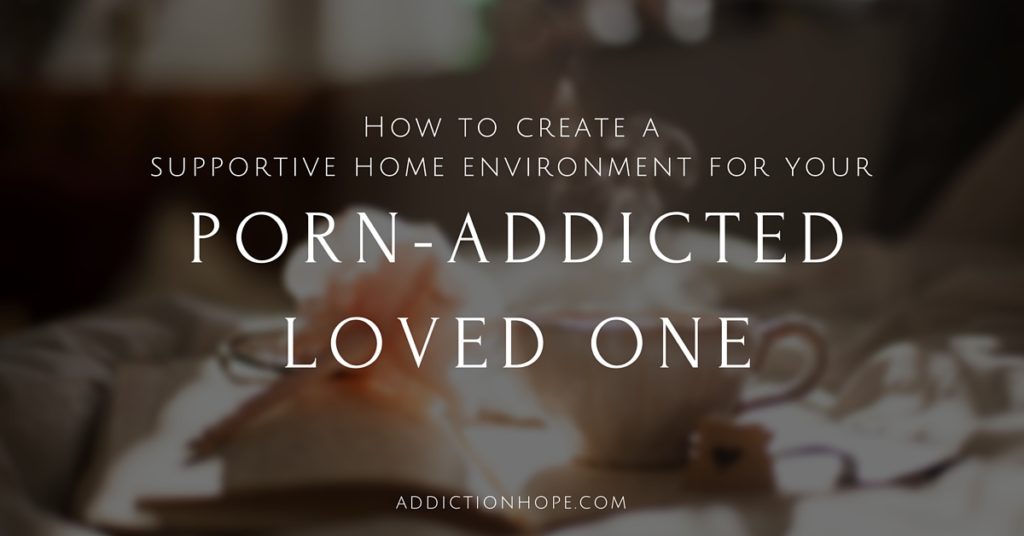
Contributed by Paul Loosemore, MA, PLPC, writer for Addiction Hope.
Think of a seesaw. Now label one end "change," and the other "stability."
It is helpful to think of creating a supportive home environment for pornography recovery using this analogy. There needs to be change to keep people safe, build trust and enhance recovery.
However, you need stability in the home to facilitate the very same things! Children are very susceptible to adverse effects if the seesaw isn’t balanced well.
Emotional Communication At Home
One of the biggest traps and triggers for those with pornography addiction is their own emotions. Often, they haven’t learned how to meet their emotional needs or communicate them with others in a healthy way. The family should try to grow in their ability to name, express and engage with emotions as much as possible.
This primarily happens with modern adults breaking the old patterns of "keeping it in," or "blowing up."
How? Start by recognizing when you feel something impacting you and express it in the following way: “I feel…” plus one of the following:
- “I need…”
- “I would like…”
- “I’m thinking that…”
Children can be coached to use this same model. As the family is able to better put words to experience, the porn addict has a model and children feel safer. You must be sensitive to what is appropriate for children’s ages, and that they are not part of the marriage, but the family. Change this area, but don’t make communication fake or totally different: Be yourselves, but more honest.
Genuine Support For Each Other
Support is needed for everyone. The expression of wants and needs has to come in an environment where everyone is on the same team! Set up rules and assumptions that help you work toward goals as a family, designed around the addict’s recovery and building a thriving home.
Recovery can be long and painful, so support is necessary for the addict to continue healing and feeling connected. Yet, a partner needs support in their healing from betrayal, and children need support to ask questions and be appropriately included in the evolving family.
Build a culture of pride and praise in the home where you actively recognize positive signs, events and times together. Make a point of noticing and appreciating the positive qualities in all members of the family. Grow this naturally so it doesn’t feel fake.
Enforced Boundaries
The addict needs to have boundaries that are set in place. The partner must know what these are and have the addict agree to them. This way the “no-go zone” is clearly delineated and everyone is on the same page.
The no-go zone may include TV shows, internet access or any number of behaviors or activities that the addict agrees not to engage in. It is very helpful to outline specific results that will follow any no-go-zone infringements made by the addict.
Results should take into account the safety and well-being of all family members. This might include asking the addict to leave for a defined period, or make costly (not necessarily financial) reparations to the family. If older children are in the home, they should be aware of the general outline of the offenses and demarcated no-go zones.
The results (consequences) should be enforced by all members of the family as appropriate. They are an important behavioral part of the addict’s recovery program, which includes making sure the family is protected. The results should take into account stability and change for the family’s best interest.
Room Changes, If Necessary
Sometimes changing the location of particular rooms or technological devices is beneficial in the house. For example, an addict’s study may be moved from the basement to a corner of the dining room. Or the TV might be moved from a concealed den into an open space. Furthermore, this can be an important psychological shift for the addict who has built up associations in their brain between locations and acting out.
Stability can be compromised here, and it is worth setting these changes within a positive context – such as a family project or redecoration effort. They can also be a symbolic reminder of the positive changes the family is engaging in.
Access Planning and Prevention
Clearly, access to pornographic or suggestive materials must be addressed. All access to pornography should be cut off: Use device-filtering, accountability and router-filtering software.
Also, carefully assess which materials could be found downloaded, purchased or located in the house. These should be removed so curious children cannot stumble upon them. This may warrant an honest conversation with the addict about previous use and locations of materials.
This strategy may have to include a lot of change because removing access is critical. Secure all family points of contact to potential dangers.
A Continuing Conversation To Foster A Supportive Home Environment
The family should be having an ongoing, age appropriate conversation about sex, appropriate boundaries and harmful activities (such as pornography). “The talk” is an unhelpful paradigm when thinking how to raise kids in a sexually saturated culture. Conversations about changes in the family, bodies, technology—you name it—should be integrated into a healthy, honest family conversation that naturally (as much as possible) occurs.
Finally, remember that everyone in the family is affected and needs different care for a full recovery. This includes children who don’t know about the issue at hand. They will have been affected indirectly.
Community Discussion: Share Your Thoughts Here
What boundaries have you set in your home regarding the use of technology? Even if it doesn't relate to pornography, please share your input in the comment section below.
 About the author: Written by Paul Loosemore, MA, PLPC. Paul, the founder of www.stopsexualaddiction.com, works as a mental health counselor and consults with those who wish to recover from sexual addiction.
About the author: Written by Paul Loosemore, MA, PLPC. Paul, the founder of www.stopsexualaddiction.com, works as a mental health counselor and consults with those who wish to recover from sexual addiction.
The opinions and views of our guest contributors are shared to provide a broad perspective of addictions. These are not necessarily the views of Addiction Hope, but an effort to offer wider discussion of various addiction and mental health issues.
